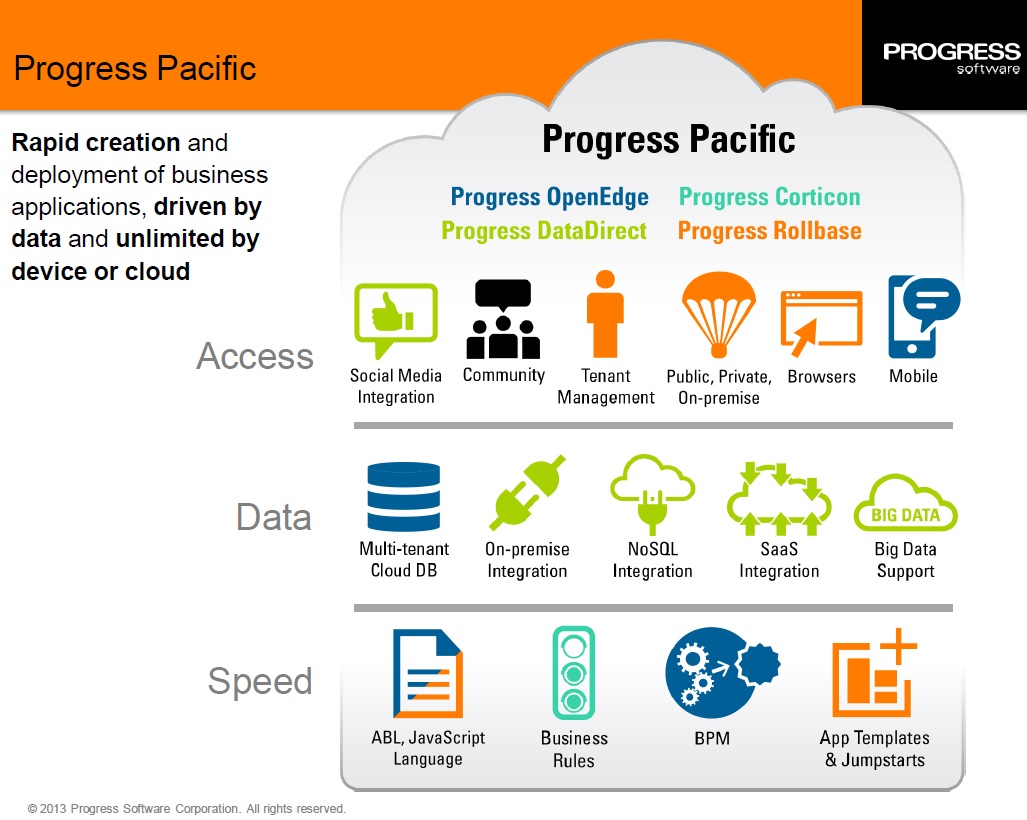DIY business apps: Getting rid of the IT middleman
By Stephanie Augustin September 5, 2013
- No longer just IT: Business people are buying tech to build applications themselves
- Progress primarily targeting South-East Asian developer network to kickstart uptake
 WITH technology trends and business applications evolving very quickly, by the time budgets are approved for IT spend, the software in question may no longer be relevant.
WITH technology trends and business applications evolving very quickly, by the time budgets are approved for IT spend, the software in question may no longer be relevant.
Add to that a disconnect in bandwidth capabilities across the region (sometimes, within a single country), and it makes for a confusing IT sphere to navigate in and cater to different business needs – something Massachusetts-based Progress Software aims to address with its Pacific solution.
Last month’s launch of Pacific, its Application Platform as a Service (aPaas) solution, is the first time Progress Software has bundled its signature OpenEdge development platform with browser-based Rollbase.
The latter is touted as a quick app-builder for those with no technical know-how to drag-and-drop their way to new software in hours.
“Interestingly, it was always technology people who bought technology, but today, business people are buying our offerings because they can build applications themselves,” Progress Software Asia Pacific and Japan managing director Stephen McNulty (pic) said.
“In several hours, you can build something substantial without any programming knowledge, so it is an interesting bridge between IT and business where you don’t have to be a techie to build software,” he added.
McNulty claimed that OpenEdge has “tens of thousands of customers globally, is established, robust and has complex rules. But that brings in complexity in software development, and a business user would not just jump into that.
“Rollbase is quite the opposite. There’s virtually no coding, and you can build lots of applications. So we paired Rollbase’s ease-of-use with the depth, functionality and capability of OpenEdge for a good combo,” he said.
While business owners may design their own apps, many Progress customers are still independent software vendors (ISVs) who leverage Pacific for their own clients.
These ISVs are a diverse lot, from those in the healthcare, manufacturing and mortgage industries to the government sector.
“We have templates designed around functionalities used by many industries like customer relationship management (CRM)-type applications,” McNulty said.
“If you select and install one of those templates, you then have a pre-built application that you can add and subtract features from, and these can be applied widely.
“When our IT customers build software or hardware, they need a customer service component to do follow-ups. Thus, there is a built-in template for tracking bugs in hardware and software computer systems, specific to IT players,” he said.
 Allowing for different bandwidths
Allowing for different bandwidths
One Progress Software customer helps organise patient records for Vietnam hospitals.
“The complexity of Vietnam is that in the major cities you have very good telecommunications support, but elsewhere the infrastructure is not so robust.
“Thus, we built some field and unique situations to allow patient records and control around Vietnam. Everything is held centrally but deployed locally so bandwidth is not an issue,” McNulty claimed.
Pacific (click to enlarge chart) addresses this particular pain point by being flexible and light, he said. “Recently we built an application on our public cloud, which is based out of the United States and runs on Amazon Web Services, and it was extremely fast.
“Now, that does not suit everyone. Some countries and industries, particularly banks, insurers and those in healthcare have to adhere to data sovereignty and security laws about data being held outside the country.
“So we give them the flexibility to deploy in three ways: Leave data on our public cloud like Amazon’s, store in a local cloud with a telco like Maxis or DiGi, or in a private data centre,” he said.
And if customers choose to deploy on a local cloud, they pay the infrastructure costs to the cloud provider. For those who deploy in their own data centre, they will have to hire staff for upgrades. In these cases, their monthly payment to Pacific is reduced.
From maintenance to creation
Formerly, big ICT projects used to involve a long process: You have an idea, engage a consultant, write a request for proposal (RFP), get five to 10 software companies to come in and do demonstrations, and after all that, you then install the software.
This process can take two years, but McNulty is now seeing is a big trend away from that.
“When people have needs that can be serviced very quickly by a software-as-a-service (SaaS) application, they will sign up for it. The trend has been growing in the industry for a long time, and it is absolutely big in Asia.
“While years ago people did not necessarily want to build bespoke or custom applications because they needed armies of developers, now they have the tools to build applications very quickly.
“And they can use an application for a year and if they do not like it, they can stop using it and build something else. Development costs are now so much lower than a few years back,” he added.
Another customer, an Australian agricultural giant, not only designed custom software, but profits more by licensing it out to global players.
McNulty recalled, “In four hours, we built an application that impressed them so much that they then applied for a budget from their board. Two weeks later, they had funding to build a full production system, which they could then sell to their customers.
“They now have one month to build, deploy and have it running live. For the agriculture industry, the harvest season starts in November so they need this application deployed by the Nov 1 deadline.
“While this application costs tens of thousands of dollars, the amount of money they will make in November vastly exceeds what it cost them to build the application.
“In Australia, the agriculture industry is quite large but there are obviously larger markets in America, so they want to take this application and start selling it globally as well,” he said.
Integrating providers, databases
But no application is an island, and often making new software and old software interact across different databases becomes a problem of its own, and that’s where Data Direct Cloud (DDC) comes in by linking data sources.
“If you were to build a time and expense (T&E)-type application, you might want it to connect to your finance system so you can pay people, or the human resource system, so you don’t have to worry about employee data.
“You can build an application to connect with 15 other applications. Years ago, it was easier because all your applications were running in your data centre – so you knew where the data was and its structure – and you could integrate.
“Today, it is much harder because one of the T&E integration points is with the enterprise resource planning (ERP) system in your data centre, and two or three other points to a SaaS based CRM payment or HR (human resource) system, by different vendors on different databases.
“So if you want to build an application, then to build all the integration points is going to be complicated. You then have to maintain it everytime a SaaS vendor changes or upgrades his database,” McNulty said.
DDC allows users to build an application and connect it one time to DDC. Progress Software then, within the cloud, manages all the integration points across the different databases like Oracle and SQL, big data sources like Hadoop and social media such as LinkedIn, Facebook and Google Plus.
Looking ahead, Progress Software is still primarily targeting the South-East Asian developer network to kickstart Pacific uptake.
“Our biggest Rollbase market in the region is the Philippines; we are also focusing on Singapore, Malaysia and Indonesia, with plans to enter Thailand and Myanmar later on.
“Most of the South-East Asian uptake we see come from small and medium enterprises (SMEs) such as entrepreneurs who have unique business ideas and want to build something fast with minimal technical know-how,” McNulty said.
Related Stories:
Progress Software moves forward with new aPaaS features
IBM out to bridge gap between business and IT
IT management today is more complex, CA hopes to simplify it
HP accelerates app development on the cloud
For more technology news and the latest updates, follow @dnewsasia on Twitter or Like us on Facebook.


